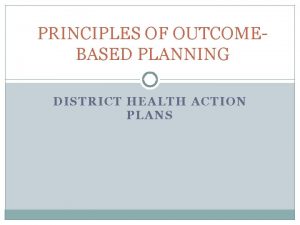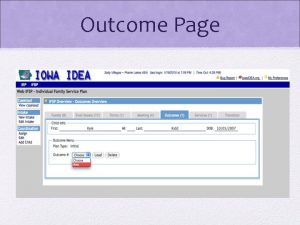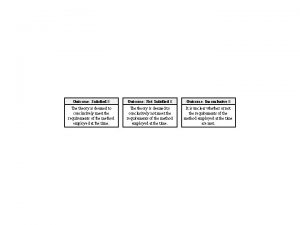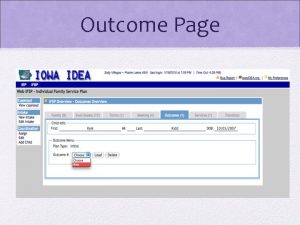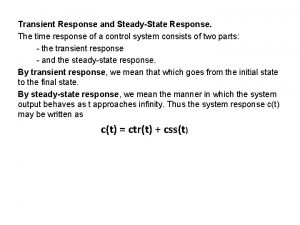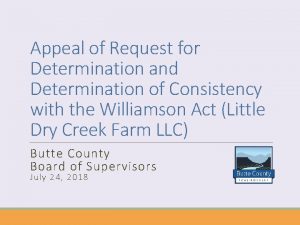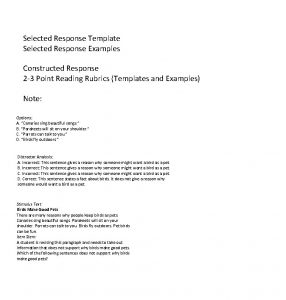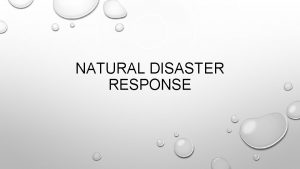Outcome and Response Planning Outcome The determination of












































- Slides: 44

Outcome and Response Planning

Outcome The determination of need that is based on an assessment Must be least restrictive Be implemented via a response plan

Response Plan – What Not To Do Bob Newhart's version of Response Planning http: //www. youtube. com/watch? v=Ow 0 lr 63 y 4 Mw

Least Restrictive Thinking Now we can talk about coming up with an outcome and creating an appropriate response plan Some things to keep in mind: What is the least restrictive approach What is needed right now What am I trying to achieve Is this in the best interest of the individual in crisis- am I keeping their integrity intact and attempting to respond to their desires regarding their treatment When in doubt reach out

Outcomes- Tiers of Restriction Ø Home individually with crisis stabilization phone calls Ø Support/ supervision by family/ friends at home or alternative residence. Ø Voluntary admission to a crisis stabilization bed Ø Voluntary hospital admission to inpatient behavioral health unit Ø Emergency Detention (51. 15) or Incapacitation Hold (51. 45) or Protective Placement(55)

Response Planning-Defined “Response plan” means the plan of action developed by program staff under s. DHS 34. 23 (5) (a) to assist a person experiencing a mental health crisis. Staff of the program shall prepare and initiate a response plan consisting of services and referrals necessary to reduce or eliminate the person's immediate distress, de-escalate the present crisis, and help the person return to a safe and more stable level of functioning. Response planning should be a risk assessment based determination.

Preparing to talk about a response plan Individuals who feel listened to and accepted are more likely to engage in problem solving. A safety/response plan should be a discussion and an agreement with the individual, not a prescription for the person. The power of agree vs. will

Home Individually What are their plans for the next 24 hours Coping skills that work /suggested Who can they reach out to in the community for support Identify and outline any upcoming appointments Encouragement to engage crisis if needed

Home Individually w/Stabilization Calls Stabilization Plans-Phone Contacts: During assessment and determination of need there are times when persons with minimal or no appropriate or available supports may benefit from scheduled telephone contacts. These scheduled contacts can assist in stabilization of a person’s crisis, when support is deemed a necessary protective factor.

Home Individually w/Stabilization Calls When setting up phone stabilization consider: Concerns of risk/safety Is there a schedule to should be aware of? Anything that staff should be inquiring /questions to ask? How will call staff know if the situation has escalated? What to do in the event that staff are unable to reach the person General Rule: Two attempts will be made, and then a welfare check will be completed, unless otherwise specified.

Community Supports Education is imperative during this time. Educate about firearms and other potential hazards related to safety and risk. How much support is needed and for how long? Is the supervising person capable of the task- i. e. supervising children, working, intoxicated

Community Supports Does the plan fit the needs of the client and support person(s) Include steps that will help all parties get through the crisis after professionals leave. Include follow up in the plan- support groups, therapy appointments, calling for resources etc.

Stabilization Facilities What is available for the program you work in for Adults Children

Inpatient Behavioral Health

Considering using the hospital keep in mind: Ø What are you trying to achieve with hospitalization Ø Why can’t this be achieved in the community Ø Is the person capable of making this determination and understanding the difference between “hospital admission” and “inpatient behavioral health hospital admission”

Shortcomings of Hospitalization as a Treatment Option Ø Hospitalization may not provide important needed support Ø Hospitalization targets treatment of identified psychiatric symptoms but not the underlying causes of the crisis itself Ø The focus solely on symptoms during periods of crisis inhibits the enhancement of autonomy and coping skills to meet life challenges

Shortcomings of Hospitalization as a Treatment Option Ø Often neglects holistic nature of the individual Ø May be traumatic or re-traumatizing Ø At a time when people need the support of family and friends they are often isolated in hospital emergency departments and psychiatric units.

Benefits of Inpatient Hospitalization Ø Secure setting Ø Possible options for medications Ø Possible evaluation for ongoing treatment needs

Voluntary Hospitalization Ø Assure a discussion is had about what inpatient care is Ø Identify that it is needed and no lesser options are available/appropriate Ø Set up a plan for assurance of admissionstabilization call Ø Age of consent-see minor handout Ø Admission of a adult person with a guardian

Emergency Detention

51. 15 -Emergency Detention Criteria Ø The purpose of this section in Chapter 51 is to provide, on an emergency basis, treatment by the least restrictive means appropriate to the individual's needs, to individuals who meet all of the following criteria: Ø Are mentally ill, drug dependent, or developmentally disabled. Ø Are reasonably believed to be unable or unwilling to cooperate with voluntary treatment. Ø There is evidence of one of the following:

51. 15 -Emergency Detention Criteria ØSubstantial probability of physical harm to self or others ØUnable to satisfy basic needs ØSubstantial probability of physical impairment or injury to self or others due to impaired judgment

“Least Restrictive Alternative” A requirement has been added to Chapter 51 that the law enforcement officer (or other authorized person) must have cause to believe, in addition to “mentally ill” and “dangerous, ” that “taking the person into custody is the least restrictive alternative appropriate to the person’s needs. ” Crisis workers should be able to substantiate- through collaboration, assessment and documentation - that an Emergency Detention was the least restrictive response

Liability 51. 15 (11) LIABILITY. Any individual who acts in accordance with this section, including making a determination that an individual has or does not have mental illness or evidences or does not evidence a substantial probability of harm …is not liable for any actions taken in good faith. The good faith of the actor shall be presumed in any civil action. Whoever asserts that the individual who acts in accordance with this section has not acted in good faith has the burden of proving that assertion by evidence that is clear, satisfactory and convincing.

Emergency Detention - Mental Illness Ø “Mental illness”, for purposes of involuntary commitment, means a substantial disorder of thought, mood, perception, orientation, or memory which grossly impairs judgment, behavior, capacity to recognize reality, or ability to meet the ordinary demands of life, but does not include alcoholism. Ø Crisis workers do not diagnosis clients, rather determine symptoms of mental illness and/ or apparent mental illness.

Emergency Detention - Drug Dependent Ø “Drug dependent” means a person who uses one or more drugs to the extent that the person’s health is substantially impaired or his or her social or economic functioning is substantially disrupted. Does not include alcoholism.

Emergency Detention - Developmental Disability “Developmental disability” means a disability attributable to brain injury, cerebral palsy, epilepsy, autism, Prader−Willi syndrome, intellectual disability, or another neurological condition closely related to an intellectual disability or requiring treatment similar to that required for individuals with an intellectual disability, which has continued or can be expected to continue indefinitely and constitutes a substantial handicap to the afflicted individual. Developmental disability does not include dementia that is primarily caused by degenerative brain disorder. Developmental disability, for purposes of involuntary commitment, does not include cerebral palsy or epilepsy.

Emergency Detention -Dangerousness to Self 51. 15 (1) (a) 1. A substantial probability of physical harm to himself or herself as manifested by evidence of recent threats of or attempts at suicide or serious bodily harm.

Emergency Detention-Dangerousness to Others 51. 15 (1)(a) 2. A substantial probability of physical harm to other persons as manifested by evidence of recent homicidal or other violent behavior on his or her part, or by evidence that others are placed in reasonable fear of violent behavior and serious physical harm to them, as evidenced by a recent overt act, attempt or threat to do serious physical harm on his or her part.

Emergency Detention -Impaired Judgment 51. 15 (1)(a) 3 A substantial probability of physical impairment or injury to him/her self or other individuals due to impaired judgment, as manifested by evidence of a recent act or omission. The probability of physical impairment or injury is not substantial under this subdivision if reasonable provision for the individual’s protection is available in the community and there is a reasonable probability that the individual will avail himself or herself of these services or, in the case of a minor, if the individual is appropriate for services or placement under s. 48. 13 (4) or (11) or 938. 13 (4). Food, shelter or other care provided to an individual who is substantially incapable of obtaining the care for himself or herself, by any person other than a treatment facility, does not constitute reasonable provision for the individual’s protection available in the community under this subdivision.

Emergency Detention- Inability to Care For Self 51. 15 (1) (a) 4. Behavior manifested by a recent act or omission that, due to mental illness he or she is unable to satisfy basic needs for nourishment, medical care, shelter, or safety without prompt and adequate treatment so that a substantial probability exists that death, serious physical injury, serious physical debilitation, or serious physical disease will imminently ensue unless the individual receives prompt and adequate treatment for this mental illness DRUG DEPENDENCY IS NO LONGER ABLE TO BE THE ONLY CRITERIA USED WITH THIS STANDARD

Additional Involuntary Holds

51. 45 – Incapacitated by alcohol Ø “Incapacitated by alcohol” means that a person, as a result of the use of or withdrawal from alcohol, is unconscious or has his or her judgment otherwise so impaired that he or she is incapable of making a rational decision. Ø Evidenced objectively by such indicators as extreme physical debilitation, physical harm or threats of harm to self or others

51. 45 - Incap Ø This is a legal hold Ø Which facilities Ø Who makes this decision Ø How long

Chapter 55 - Emergency Protective Placement Chapter 55 provides a way to intervene in an emergency situation if it “appears probable that an individual is so totally incapable of providing for his or her own care or custody as to create a substantial risk of serious physical harm” to self. Ø This is a legal hold Ø May not be done to a locked inpatient unit

Comparison of Chapter 51 and 55 One should not make a snap judgment based on age or diagnosis as to whether to use Chapter 51 or 55. It is best to look at what services the person wants, what services are needed, and then look at which chapter can best provide those services. Both Chapter 51 and Chapter 55 contain a provision to convert the proceeding to the other chapter if necessary. Both require all lesser restrictive options be explored first

51 55 Treatment Long Term Care Through treatment the goal is recovery The person’s disability is permanent or likely to be permanent. Own person Deemed incompetent

Additional Potential Outcome

Medical Treatment Primary Understanding the difference Ø Medical clearance occurs at the nearest hospital/ emergency department in order to ensure that the person under consideration for a possible emergency detention is medically stable for transport to an approved treatment facility, and/or whether a medical condition may be contributing to the person’s current crisis Ø Medical treatment - through the process of medical clearance a medical concern has been identified which is primary over behavioral health treatment. Client may be admitted to hospital/medical floor for treatment of medical issue. Ø If medical treatment is primary, a risk assessment can be conducted once the person is medically stabilized and ready to discharged

Jail Specific

Working in the jail It is important to keep work in the jail in the context of crisis unless you are the ongoing treatment provider within the jail Each county is a bit different in each jail-see county specific directives regarding this

Response Plan-Jail If the client is not currently already on precautions when you are called/sent and they are not being released into the community (these are your ONLY 3 options): Following my assessment of this client my recommendation is no risk of harm to self or others is noted indicating precautions. Following my assessment of this client my recommendation is not an Emergency Detention however, I do believe that based on the following risk(identify risk) the most appropriate response plan is precautions. Please follow your internal policy regarding precautions. Our agency may be called back for re-assessment only if something has changed and it is believed that this client may need to be moved to an emergency detention. Our program can NOT remove anyone from jail precautions. Following my assessment of this client my recommendation is an Emergency Detention

Response Plan-Jail If the client is already on precautions when you are called/sent and they are not being released into the community (these are your ONLY 2 options): Following my assessment of this client my recommendation is an Emergency Detention Following my assessment of this client my recommendation is not an Emergency Detention. As this client is already on jail precautions a DHS staff member will need to determine if they can be removed during non business hours. Our agency may be called back for re-assessment only if something has changed and it is believed that this client may need to be moved to an emergency detention. Our program can NOT remove anyone from jail precautions.

Response Plan-Jail If the client is being released and they were on precautions or the jail believes their to be concerns of a crisis: Assess, contact clinical, outline a response plan or approve an ED. Due to significant change in this person’s setting a clinical consultation plays a huge piece in verifying you have covered all aspects of a higher risk response plan.
 Natural response and forced response
Natural response and forced response First order system transfer function
First order system transfer function A subsequent
A subsequent District health action plan
District health action plan X linked punnett square
X linked punnett square Sex determination in drosophilla
Sex determination in drosophilla Determination and description of material quality
Determination and description of material quality Price and output determination under oligopoly
Price and output determination under oligopoly Sex determination and sex linkage
Sex determination and sex linkage Spi in software engineering
Spi in software engineering Price and output determination under monopoly
Price and output determination under monopoly Exchange rate determination and forecasting
Exchange rate determination and forecasting Price discovery and price determination
Price discovery and price determination N planning
N planning Long term plan and short term plan
Long term plan and short term plan Figurative language slideshare
Figurative language slideshare Hát kết hợp bộ gõ cơ thể
Hát kết hợp bộ gõ cơ thể Lp html
Lp html Bổ thể
Bổ thể Tỉ lệ cơ thể trẻ em
Tỉ lệ cơ thể trẻ em Chó sói
Chó sói Chụp tư thế worms-breton
Chụp tư thế worms-breton Chúa yêu trần thế
Chúa yêu trần thế Môn thể thao bắt đầu bằng chữ đua
Môn thể thao bắt đầu bằng chữ đua Thế nào là hệ số cao nhất
Thế nào là hệ số cao nhất Các châu lục và đại dương trên thế giới
Các châu lục và đại dương trên thế giới Công thức tính thế năng
Công thức tính thế năng Trời xanh đây là của chúng ta thể thơ
Trời xanh đây là của chúng ta thể thơ Cách giải mật thư tọa độ
Cách giải mật thư tọa độ Làm thế nào để 102-1=99
Làm thế nào để 102-1=99 độ dài liên kết
độ dài liên kết Các châu lục và đại dương trên thế giới
Các châu lục và đại dương trên thế giới Thể thơ truyền thống
Thể thơ truyền thống Quá trình desamine hóa có thể tạo ra
Quá trình desamine hóa có thể tạo ra Một số thể thơ truyền thống
Một số thể thơ truyền thống Bàn tay mà dây bẩn
Bàn tay mà dây bẩn Vẽ hình chiếu vuông góc của vật thể sau
Vẽ hình chiếu vuông góc của vật thể sau Biện pháp chống mỏi cơ
Biện pháp chống mỏi cơ đặc điểm cơ thể của người tối cổ
đặc điểm cơ thể của người tối cổ Thế nào là giọng cùng tên? *
Thế nào là giọng cùng tên? * Vẽ hình chiếu đứng bằng cạnh của vật thể
Vẽ hình chiếu đứng bằng cạnh của vật thể Vẽ hình chiếu vuông góc của vật thể sau
Vẽ hình chiếu vuông góc của vật thể sau Thẻ vin
Thẻ vin đại từ thay thế
đại từ thay thế điện thế nghỉ
điện thế nghỉ



